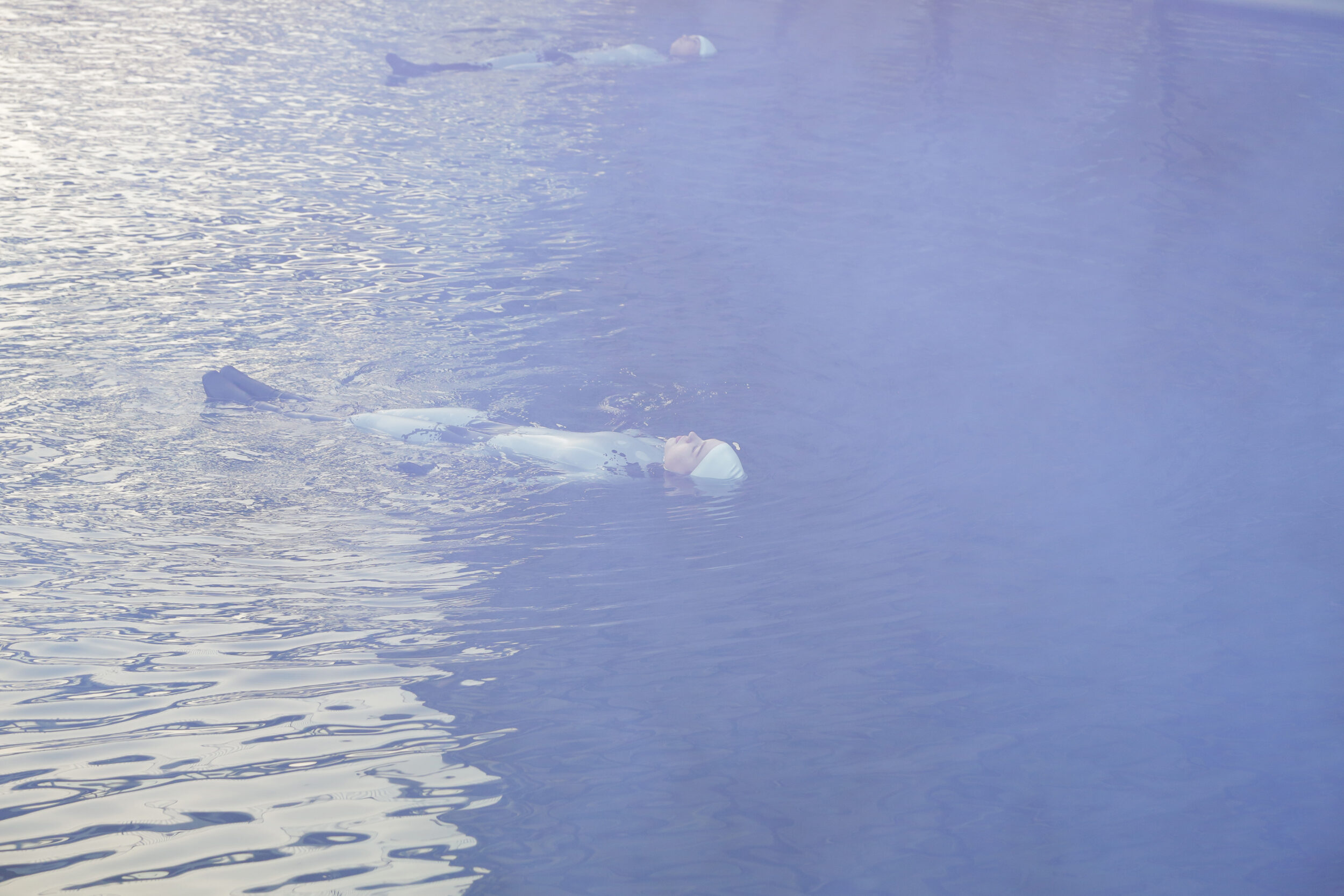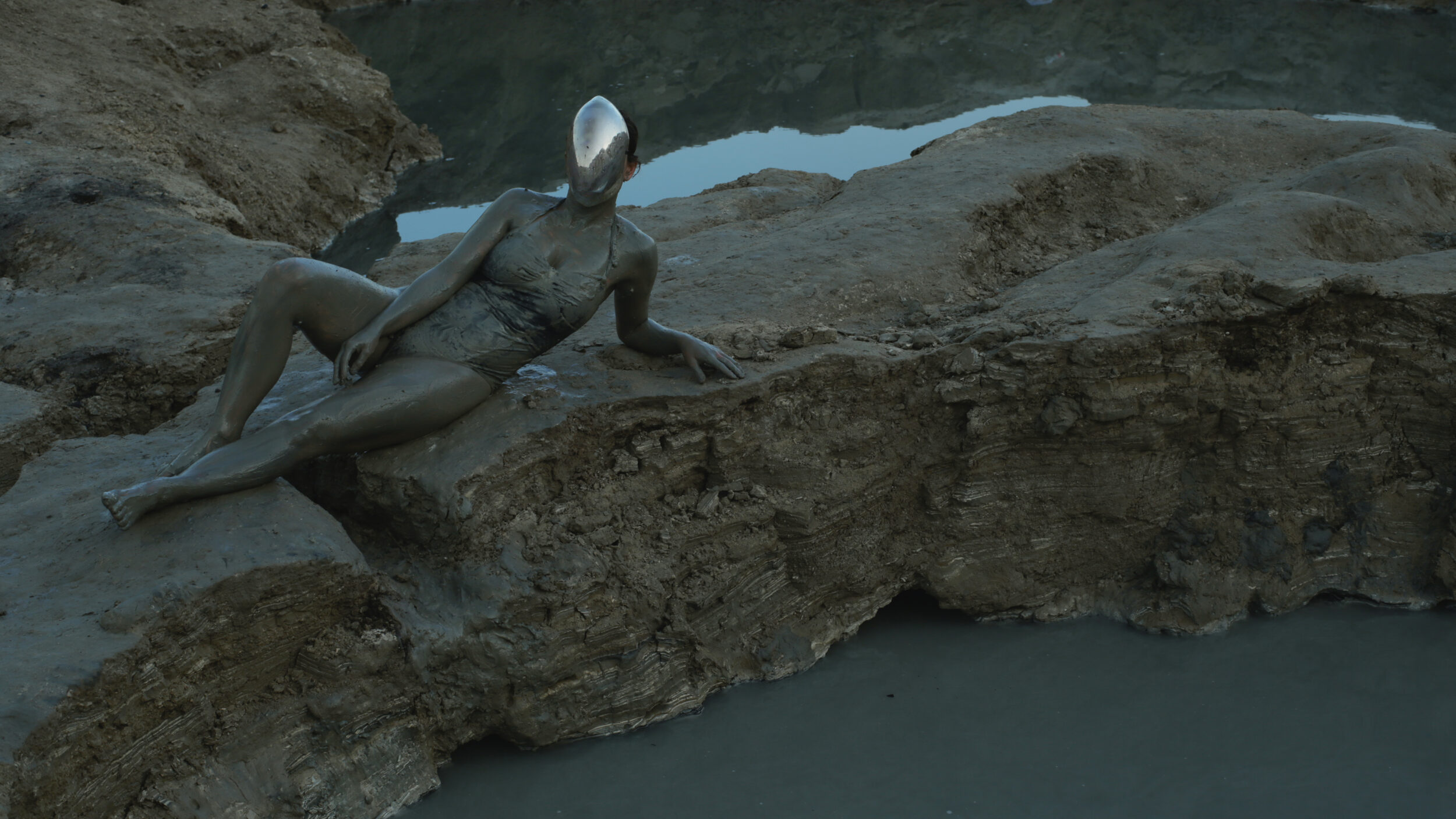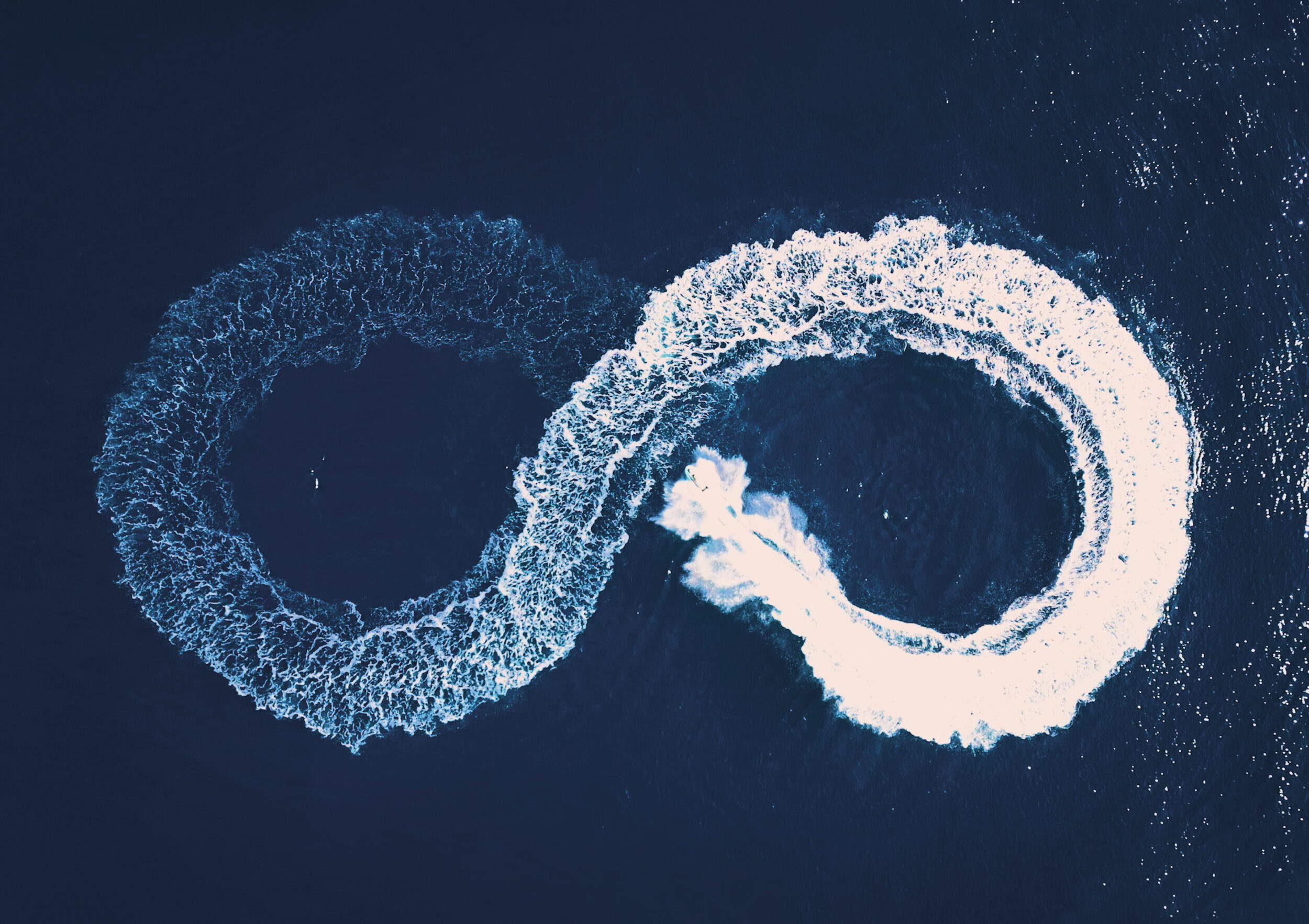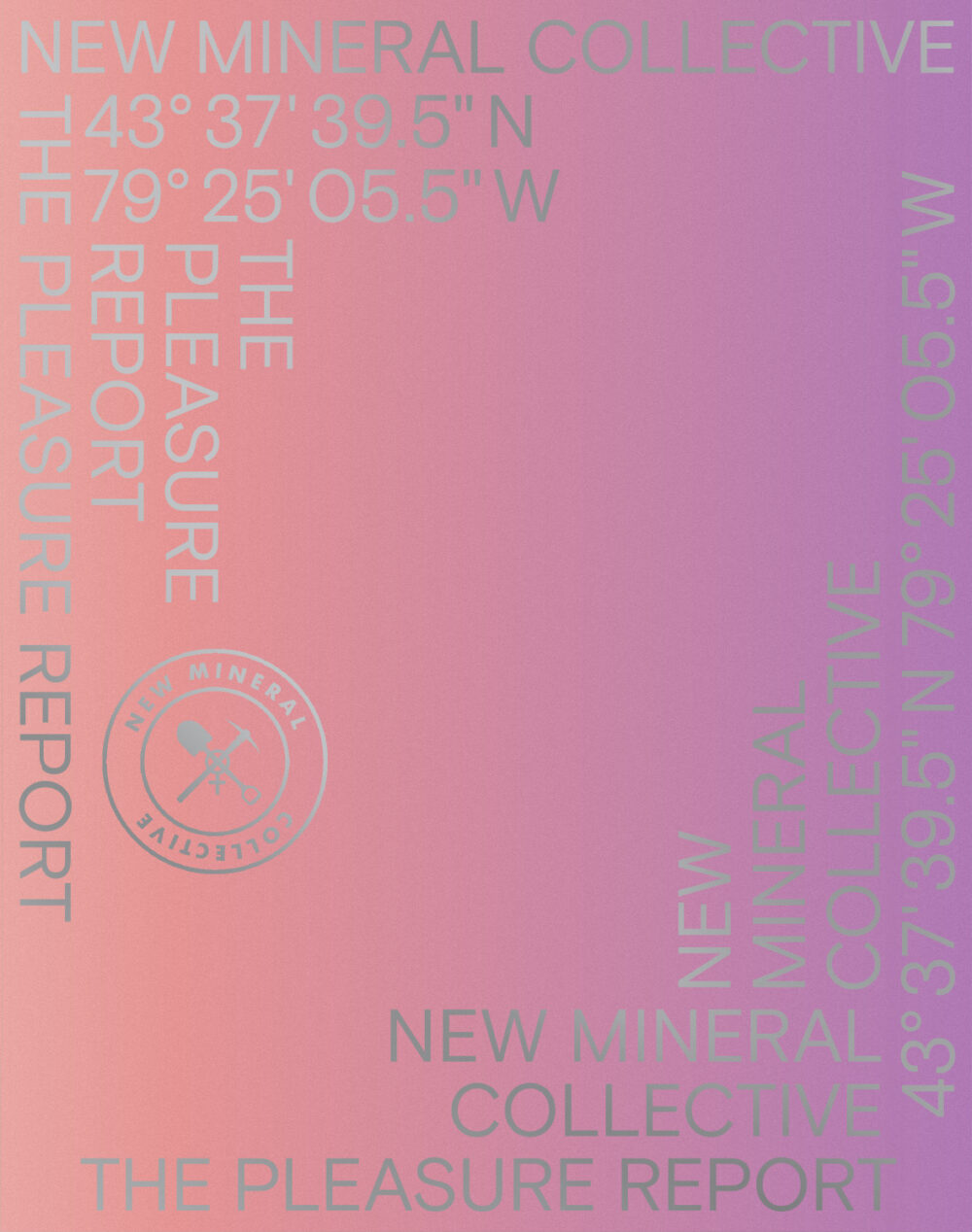
New Mineral Collective: The Pleasure Report
- Artists
- Tanya Busse, Emilija Škarnulytė
- Language
- English
- Format
- Hardcover
- Size
- 170 x 230mm
- Extent
- 144
- Release
- 2025
- ISBN
- 978-1988860190
- Price
- 45
New Mineral Collective: The Pleasure Report delves into the groundbreaking practice of New Mineral Collective (NMC), a collaborative art initiative by Tanya Busse and Emilija Škarnulytė, which explores the intersections of land, body, and extractive industries. This publication examines the processes and conceptual provocations underpinning NMC’s work over the past decade, including projects such as Pleasure Prospects for the 2019 Toronto Biennial and Hollow Earth (2013).
Framed by speculative futures, geotrauma healing, and counter-prospecting—an innovative act of claiming mineral rights to prevent extraction—NMC challenges destructive mining narratives by envisioning alternatives rooted in care, slowness, and reparative futures. From the corporate spectacle of the PDAC mining conference to the haunting yet utopian architecture of Ontario Place, their work reimagines landscapes—both physical and metaphorical—as spaces of resistance, memory, and pleasure. The publication offers a poetic and activist perspective on the scars of extraction, revealing how land, like the body, remembers and heals. Featuring texts by Audre Lorde, Kjerstin Uhre, Quinn Latimer, Susan Reid, and Astrida Neimanis; poetry by Cecily Nicholson; and an interview between editor Jayne Wilkinson, curator Candice Hopkins, and New Mineral Collective.
The erotic is a resource within each of us that lies in a deeply female and spiritual plane, firmly rooted in the power of our unexpressed or unrecognized feeling. In order to perpetuate itself, every oppression must corrupt or distort those various sources of power within the culture of the oppressed that can provide energy for change.
Audre Lorde, "Uses of the Erotic: The Erotic as Power," repr. from Sister Outsider.
Contributors
-
New Mineral Collective
is a platform of enquiry run by Emilija Škarnulytė and Tanya Busse that observes human interaction with the earth’s surface. Against tense contemporary political landscapes, escalating climate crisis, and greed, their practice presents a speculative future with reparative alternatives to the damaging extractive activities that warp both the earth’s surface and capitalist societal values. In their work, boundaries between body and land dissolve as both are understood to be threatened by large-scale extractive industries, and therefore require care, remediation, and acts of counter-prospecting. Their work has been shown nationally and internationally, including at KUBE (Ålesund), University of Queensland Art Museum, Lofoten International Art Festival, Tate Modern’s Starr Cinema (London), Serpentine Cinema at Serpentine Galleries (London), Künstlerhaus Bethanien (Berlin), Kunstnernes Hus (Oslo), Swedish Center for Architecture and Design (Stockholm), Toronto Biennial of Art, SeMA Seoul Museum of Art, and SIART Bolivia International Art Biennial. They were also included in Artists Film International Season 7, organized by Whitechapel Gallery (London) in 2015. They have lectured at Hochschule für Bildende Künste–Städelschule, Frankfurt am Main, Tromsø Academy of Landscape and Territorial Studies, Bergen Centre for Electronic Arts, Basel Academy of Art and Design, and NSCAD University, amongst others. Their current headquarters are in Tromsø, Norway.
-
Tanya Busse
is a visual artist born in Moncton, Canada, who is currently based in Tromsø, Norway. Her practice spans moving-image, installation, and photography to explore the intersection between representations of nature and the presence of industrial or post-human traces. Her work addresses notions of deep time, invisible architectures in the present, and how power is produced and articulated through material relationships in space, both actual and historical. She has had solo exhibitions at PODIUM (Oslo), Mumbai Art Room, Röda Sten Konsthall (Gothenburg), Vaga Center for Art and Knowledge (Azores), and Entrée (Bergen); her work has been shown in group exhibitions at the 13th Turku Biennial, Greenlight Triennial, Nanaimo Art Gallery, Office of Contemporary Art (Oslo), and Bergen Kunsthall. She received an undergraduate degree from the Nova Scotia College of Art and Design in Halifax, studied at Kunsthochschule Berlin Weissensee, and holds a master’s degree from the Tromsø Academy of Contemporary Art. She is also the co-director of Mondo Books, an independent book platform that publishes and distributes artist books across the circumpolar North.
-
Emilija Škarnulytė
is an artist and filmmaker born in Vilnius, Lithuania. Working between documentary and speculative fiction, Škarnulytė’s films and immersive installations explore deep time and invisible structures, from the cosmic and geologic to the ecological and political. She is the recipient of the 2023 Ars Fennica Award and the 2019 Future Generation Art Prize. Škarnulytė represented Lithuania at the XXII Triennale di Milano and was included in the Baltic Pavilion at the 2018 Venice Biennale of Architecture. Her work has been presented in solo exhibitions at Kunsthall Trondheim, Canal Projects (New York), Kunsthaus Göttingen, and Ferme-Asile (Sion), and in group exhibtions including the 14th Gwangju Biennale, Helsinki Biennale, Henie Onstad Triennale, and at the Mori Art Museum (Tokyo). She has films in the collections of the Centre Pompidou, Kadist Foundation, Kiasma, Fondazione In Between Art Film, IFA and HAM. Her films have been screened at Tate Modern and Serpentine Galleries (London), Centre Pompidou (Paris), Museum of Modern Art (New York), and numerous film festivals, including Oberhausen, Visions du Réel, Rotterdam, and Busan. She received an undergraduate degree from the Brera Academy of Art in Milan and holds a master’s degree from the Tromsø Academy of Contemporary Art. She is a co-founder and co-director of the Polar Film Lab.
-
Candice Hopkins
is a citizen of Carcross/Tagish First Nation and lives in Red Hook, New York. Her writing and curatorial practice explores the intersections of history, contemporary art and indigeneity. She worked as senior curator for the 2019 and 2022 editions of the Toronto Biennial of Art and was part of the curatorial team for the Canadian Pavilion of the 58th Venice Biennale, featuring the work of the media art collective Isuma. She is co-curator of notable exhibitions including Indian Theater: Performance, Art, and Self-Determination since 1969; Soundings: An Exhibition in Five Parts (with Dylan Robinson); Art for New Understanding: Native Voices 1950s to Now; the 2018 SITE Santa Fe biennial, Casa Tomada; documenta 14 in Athens, Greece, and Kassel, Germany; Sakahàn: International Indigenous Art at the National Gallery of Canada; and Close Encounters: The Next 500 Years in Winnipeg, Manitoba. She is currently the executive director and chief curator at Forge Project.
-
Quinn Latimer
is a California-born poet, critic, and editor based in Basel, Switzerland, and Athens, Greece. Situated between the performance and the page, her writings take in feminist imaginaries of literature and the moving image, culture and its many natures. Her books include Like a Woman: Essays, Readings, Poems (Sternberg, 2017), Sarah Lucas: Describe This Distance (Mousse, 2013), Film as a Form of Writing, with Akram Zaatari (Wiels, 2013), and Rumored Animals (Dreaming Horse Press, 2012). Latimer is head of the MA program of the Institute Art Gender Nature HGK FHWN in Basel.
-
Audre Lorde
(1934–1992) was an American writer, womanist, radical feminist, professor, philosopher, and civil rights activist. A self-described “black, lesbian, mother, warrior, poet,” Lorde dedicated both her life and her creative talent to confronting and addressing injustices of racism, sexism, classism, and homophobia.
-
Astrida Neimanis
is a cultural theorist working at the intersection of feminism and environmental change. Her research focuses on bodies, water, and weather, and how they can help us reimagine justice, care, responsibility and relation in the time of climate catastrophe. Her most recent book, Bodies of Water: Posthuman Feminist Phenomenology, is a call for humans to examine our relationships to oceans, watersheds, and other aquatic life forms from the perspective of our own primarily watery bodies, and our ecological, poetic, and political connections to other bodies of water. Astrida is Canada Research Chair in Feminist Environmental Humanities at UBC Okanagan on unceded Syilx lands.
-
Cecily Nicholson
is the author of four books, including From the Poplars and Wayside Sang, the recipient of the Dorothy Livesay Poetry Prize, and winner of the Governor General’s Literary Award for poetry. Her collaborative practice spans municipal, artist-run centres, and community-based arts organizing and education. She is an assistant professor at the School of Creative Writing at the University of British Columbia and the 2024/2025 Holloway Lecturer in Poetry and Poetics at the University of California, Berkeley.
-
Susan Reid
is a cultural theorist, artist, writer, and creative researcher who explores multibeing ontologies with a focus on human-ocean relations, multibeing justice, and extractivism. Susan’s transdisciplinary work engages multibeing worlds, feminist and queer environmentalisms, contemporary art, law, and sciences. She holds a postdoctoral research fellowship with the University of British Columbia, titled “Multibeing Seas: Agencies of Resistance and Care,” and an ongoing affiliation with the University of Sydney’s “Extracting the Ocean” project. Some of the concepts informing the collaborative text “Water/Shelter” took shape on the unceded lands of Eora, Yugambeh, and Kamilaroi nations (Australia). Susan currently works and lives on unceded Syilx territories (Canada).
-
Kjerstin Uhre
is an associate professor in Landscape Architecture at the Academy of Fine Arts in Tromsø, Norway, and is a partner at Dahl & Uhre architects, who have received awards for their urban and built projects. She took her diploma in architecture at Bergen School of Architecture, and her PhD thesis, titled “Perforated Landscapes, contested prospects in Sápmi” is associated with Future North at the Oslo School of Architecture and Design. Through her landscape studio teaching practice, she explores, together with students, how Arctic and sub-Arctic world experiences can renew approaches, practices and methods in the field of landscape architecture.
This project is supported by the Canada Council for the Arts.

-
New Mineral Collective: The Pleasure Report
$45 -

